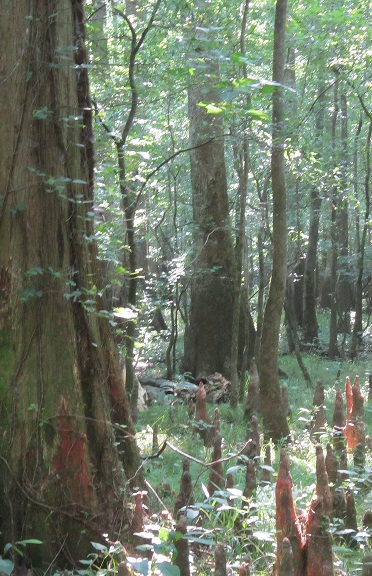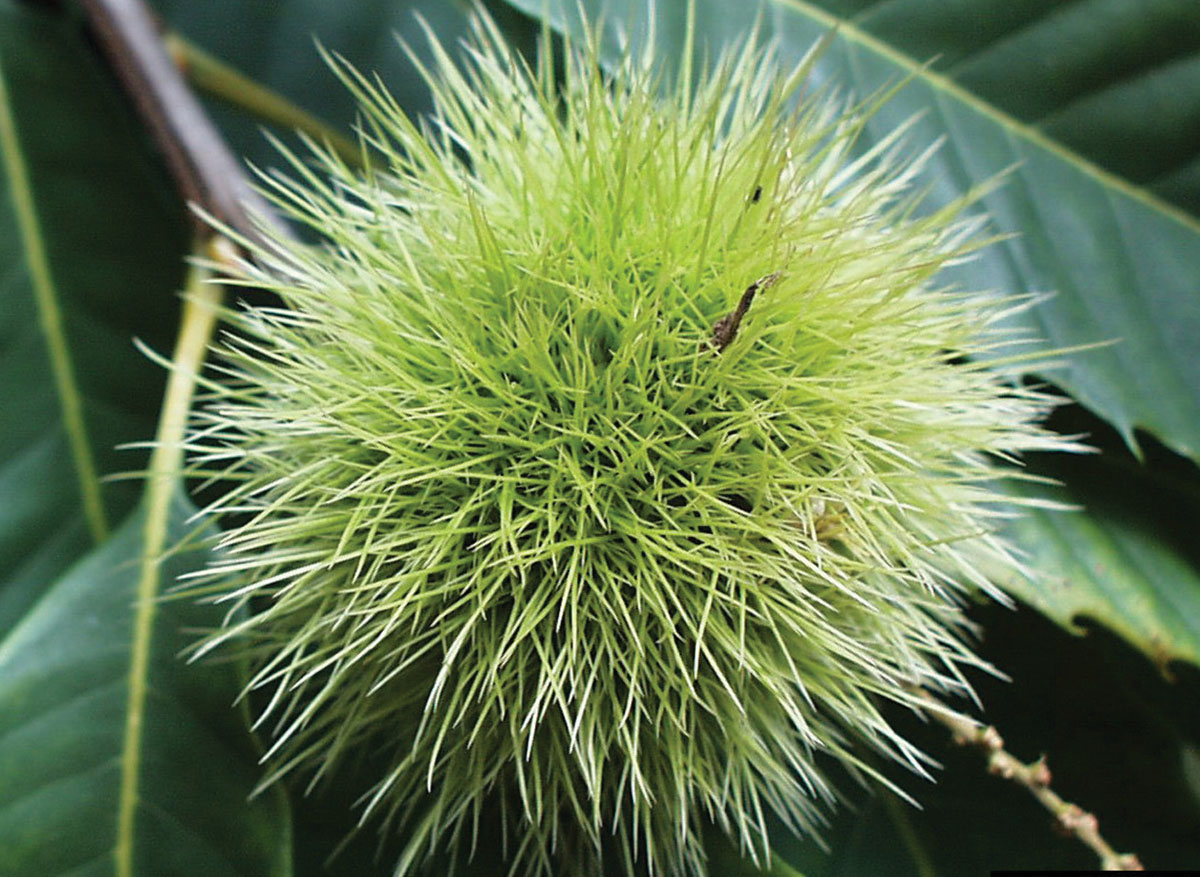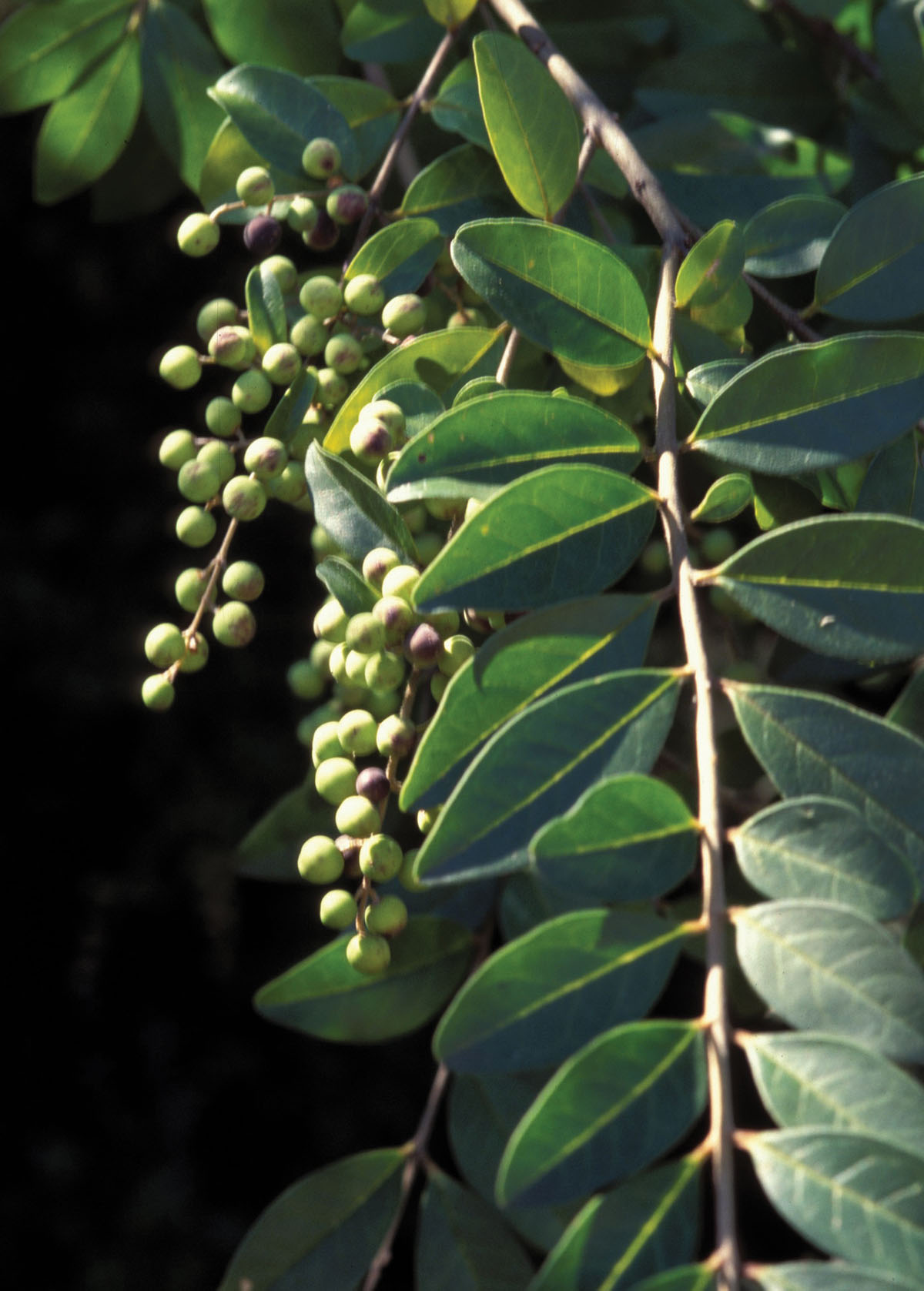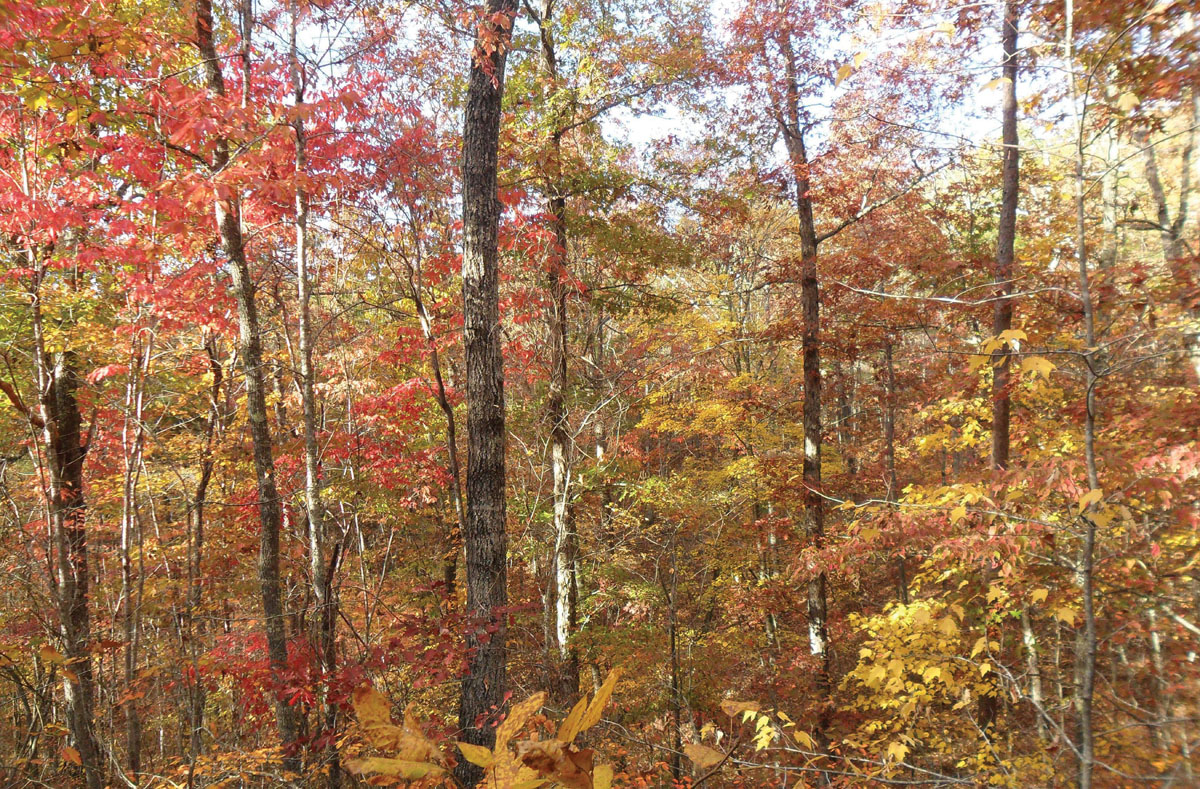Forest by Nature
stories by Jemma Everyhope-Roser
 In much of the Southeast, the landscape’s native vocation is forest. But when European settlers arrived here, they did not find a forest primeval, wild and pristine. For centuries, native people had managed the forest, extracting its resources for shelter, fiber, fuel, and food. Deer and other game thrived in understories cleared with fire. Hunters traveled shady, park-like woodlands on broad, open paths. And in clearings, native farmers sowed their crops in the fertilizing ash of trees.
In much of the Southeast, the landscape’s native vocation is forest. But when European settlers arrived here, they did not find a forest primeval, wild and pristine. For centuries, native people had managed the forest, extracting its resources for shelter, fiber, fuel, and food. Deer and other game thrived in understories cleared with fire. Hunters traveled shady, park-like woodlands on broad, open paths. And in clearings, native farmers sowed their crops in the fertilizing ash of trees.
When Europeans claimed the land, forests swiftly changed. Planters cleared the coastal swamps, ditching and draining them for rice. As settlers pushed inland, great tracts of timber fell to pasture and crops such as cotton, tobacco, and corn. By the end of the nineteenth century, even steep, rocky slopes of the mountains were stripped to their bones.
The soils of South Carolina did not fare well, laid open to weather as hungry crops mined their nutrients. By the early twentieth century, once-fertile topsoil was depleted or eroded, and the land, like most of the people who tried to farm it, was impoverished. From its inception as a land-grant college, Clemson’s mission included a mandate to rebuild the vitality of the land and the economy that depended on it. Science-based farming and forestry were the tools of choice. With time, newly planted forests healed the gullied wastelands, attracting wildlife and supplying timber to the mills.
Today, the job is not finished, and the science of forests is urgent as ever. Development, pests and diseases, and a warmer climate threaten forest ecosystems and complicate the job of using resources without exhausting them again. In these pages, you will find a few examples of research that is helping to write the next chapters on how to manage a forest.
chestnut dreams | the forest’s winged enigma | battling invasives & pine killer | the question of value |built to take the heat |salt and the cypress
Chestnut dreams
In 1905, American chestnut trees in the Bronx Zoo began to die. The zookeepers, with the help of a mycologist, discovered that chestnut blight was to blame. Chestnut blight is a fungus, Cryphonectria parasitica, thought to have originated in Asia. It had already cast its spores to the wind.
At that time, the American chestnut dominated the forests directly west of the Appalachians. Geoff Wang, a forest ecologist, estimates that the American chestnut accounted for one in four mature trees. The chestnuts fruited prolifically, and in addition to their commercial value, must have fed many wildlife species. Unfortunately, we don’t know exactly what role the American chestnut played in this ecosystem. That’s because he American chestnut was gone by the 1950s. Today, Wang says, it is “functionally extinct.” The root survives the blight and sprouts a sapling. But as soon as the sapling is old enough, the fungus kills it.
Now there is hope for the American chestnut. The American Chestnut Foundation has produced a hybrid that is 96 percent American chestnut and 4 percent Chinese chestnut, which is resistant to the blight. The tree looks like an American chestnut, but Wang and his former graduate student, Ben Knapp, now at the University of Missouri, want to learn whether it will act like one, too, physiologically and ecologically. Wang’s study is a part of the effort, led by USDA Forest Service, to find the best way to reintroduce chestnut trees so that they thrive and propagate themselves.
“It’s a dream that, one day, the Appalachian landscape may look more like it did in the past than it does today,” Wang says.
Geoff Wang is professor of silviculture and ecology in the Department of Forestry and Natural Resources, College of Agriculture, Forestry, and Life Sciences.
The forest’s winged enigma
Before the microchip, it was almost impossible to study bats. Scientists chased bats with nets or studied them in caves, where some but not all of them hibernate. It’s no wonder then that bats are still very much an enigma.
“They’re tiny. They fly at night. And that made it difficult to track them,” says Susan Loeb, a U.S. Forest Service research ecologist and an adjunct professor at Clemson.
In the 1990s, the Forest Service began investigating claims that deforestation was cutting into the endangered Indiana bat’s maternity habitat. The problem was, no one knew exactly where the Indiana bats went to raise their young. For the first time, radio transmitters were small enough for tracking bats. Loeb, who’d previously studied how the endangered red-cockaded woodpecker and flying squirrel use longleaf pine habitats, joined the project. She fell in love with bats.
“They’re fascinating animals,” she says. “Bats are really important for ecosystems, for agriculture and for forestry.” Bats, she says, control insects, pollinate crops, and spread seeds.

The little brown bat weighs only about as much as two teaspoons of sugar but can catch 1,000 mosquitoes in an hour. Photo by Ralph Eldridge.
Loeb tracked the Indiana bats using radio-telemetry, following them to their maternity roosts. “We found them roosting in deeply forested habitats, in the southern Appalachians, although they roost in woodlots in the Midwest, and even in the Indianapolis airport,” she says.
She also discovered, in the Great Smoky Mountains, the first southern maternity roosts. Oddly, the bats migrated to more northerly sites to breed. Young mammals need to be kept warm; everyone knows that. So why were the female bats going to the sunny sides of trees in cooler areas? Do bat pups also have difficulty keeping cool?
Some maternity roosts are in areas where climate models predict increasingly hot summers. Loeb wants to learn whether the bats will migrate farther north or just move to shadier trees. Figuring this out will help forest managers protect potential roosting sites.
Meanwhile, Loeb also studies a more immediate threat to bats of all cave-hibernating species: white-nose syndrome. The syndrome, caused by a cave fungus, Geomyces destructans, shows up as white fuzz around the bat’s muzzle and distinctive mildewy spots on the bat’s wings. Infected bats wake from hibernation, flying during bitter winter days in search of food they’ll never find. They die emaciated. In northern states where the syndrome first struck, 72 percent of Indiana bats and 95 percent of little brown bats died. Unlike most small mammals, bats can live to be more than thirty years old and have only one pup a year, so their populations take a long time to recover.
White-nose syndrome has been sighted at the same latitude as one of Susan Loeb’s favorite bat colonies, a group of little brown bats that roost in a fish hatchery’s shed. Loeb hopes that even if these bats wake from hibernation, the southern winter will be so mild and short that they won’t deplete their fat stores and starve.
To help bats survive, Loeb studies their habitat. She knows that they prefer to hunt in open spaces such as meadows. Prescribed fires can burn out forest clutter and restore the pine forests bats love. Loeb is part of an interdisciplinary project in the Nantahala Forest looking at how clear cutting small patches affects bats, other animals, and people who use the forest. She hopes to learn whether bats will use these clear-cut areas to hunt insects, and what size and arrangement of spaces work best.
As disease, pesticides, habitat loss, wind turbines, and other threats keep the pressure on, Loeb will be looking for ways to keep the bats alive. “We’re only starting to learn about them and getting the tools we need to manage their habitats,” she says.
Battling invasives
Dozens of invasive species vie with natives for sunlight and nutrients. There are three simple methods to control an invasive plant species: cut it out, burn it, or poison it. Geoff Wang and graduate student Lauren Pile are exploring combinations of all three on Paris Island, trying to keep the Chinese tallow tree from taking over.
In an ideal world, you’d use a manual method, weeding out the invasive species. But with huge populations to control, the manual method is impossible. Fire is the cheapest. But it doesn’t kill invasive species—it only limits how tall they grow between burnings. Herbicides, the most expensive option, do eradicate unwanted plants. But most herbicides don’t discriminate; they can kill desirable plants too.
Wang and graduate student Karen Vaughn are working in Congaree National Park with Chinese privet, an invasive shrub that strangles young trees. The researchers have chosen an herbicide that is absorbed through leaves, and they’re applying it in the dormant season, when most native species are leafless and the semi-evergreen Chinese privet is not.
“When an invasive species becomes abandoned in a native ecosystem, we want to know how it impacts the regeneration of native species,” Wang says. “We want to be able to bring the original ecosystem back.”
Pine killer
Tiny as a grain of rice, the southern pine beetle has caused several hundred million dollars in timber losses in the U.S. The beetle bores into trees and chews serpentine galleries into the innermost bark, stopping nutrient flow. It also spreads a fungus deadly to pines.
Especially vulnerable are the loblolly pine trees, planted for their quick growth. Unlike longleaf pines, loblollies don’t cope well with drought, which lowers their resistance to beetle attacks.
Geoff Wang’s research is aimed at helping forest managers restore beetle-damaged forests.
The question of value
How can you measure a tree’s economic worth? It’s a question people ask Thomas Straka, an expert in forest economics. Trees, he says, are one of the few goods that accrue value as they age. But it takes complex calculations—using wood yield and valuation functions—to determine when it’s best to harvest. And the equation has to take into account more than money.
Conservation typically means using forests wisely, and a forest manager’s job is to make sure the lands serve public interests, Straka says. That means, before a manager can make decisions, he or she has to know the value of the trees in terms saleable wood, wildlife habitat, aesthetics, recreation, socioeconomics, and more. One of Straka’s recent projects uses socioeconomic data with GIS to predict wood arson, a major cause of wildfires.
Socioeconomic factors also apply in the new field of sustainable forestry. Straka works with everyone, from paper mills to private citizens, to help them attach a monetary value to sustainability. Conservation easements that compensate property owners for losses in the transition from loblolly forests to longleaf forests are one example of this approach, he says.
Straka also works on systems that will help city officials and private owners assess the value of urban trees, taking into account air-quality improvement, carbon sequestration, and storm-water reduction. If a tree shades a building, it can reduce electricity costs. Straka also accounts for the value of the tree itself, its girth, type, region, and even aesthetic value.
But a huge amount of a tree’s value comes from people’s perceptions, he says. A tree-shaded shopping district may attract customers and generate revenue. People especially like oak trees, Straka says, because we view them as a long-term investment. “If you have a beautiful live oak in your front yard that’s two hundred years old,” Straka says, “how do you put a value on it?”
Thomas Straka is a professor in the Division of Forestry and Natural Resources.
Built to take the heat

When young, the longleaf pine protects its terminal bud from fire with a spray of water-dense needles. When its root is long enough, the tree armors itself in thick fire-resistant bark and shoots upward, elevating vulnerable branches above the flames. Image courtesy of the USDA Forest Service.
Usually, setting something on fire creates more problems than it solves. The longleaf pine is a notable exception.
Before European colonization, longleaf pine savanna stretched across the Southeastern coastal plains from Virginia to Mississippi. Tall pines and broad meadows composed a unique park-like vista that housed the highest biodiversity seen outside the tropics.
There were 92 million acres. Today, only 5 percent of the savanna survives. Fortunately, that’s enough to give researchers like Geoff Wang an understanding of how this ecosystem works. The keystone species is the longleaf pine, which provided both sustenance and shelter to many species, including the red-cockaded woodpecker, that are now endangered because of the longleaf pine’s decline.
The longleaf pine is uniquely adapted to regenerate after fires. As Wang says simply, “No other tree can do that.”
Native tribes burned the pine savanna every two to five years. Fire would wash through the forest, clearing the midstory and searing through normal saplings. The resulting open spaces and fertile ash gave rise to the region’s diversity.
Wang has already studied the tree’s special adaptations and the best methods to restore this ecosystem. Now he’s learning how Southeastern forests may adapt to climate change and increased drought. Using an extensive data set taken from the USDA’s Forest Service Forest Inventory Analysis (FIA) program, he’s trying to determine which species are drought resistant, which will grow more abundant, which will decrease, and what kind of stand density and conditions will help a tree flourish.
Longleaf pines grow in the driest and sandiest sites, tolerate nutrient-poor soils, and are very drought-resistant. So the longleaf pine, a survivor from the past, may come to stand for the future.
Salt and the cypress
Cypress trees, with their roots in dark mud and their leaves in the sunlight, have quietly outlived empires. With their neighboring maples, ashes, and gums, they form the basis of a complex ecosystem that once stretched along many Southeastern waterways.
William Conner has been studying these ecosystems, called freshwater forested wetlands, for about forty years. He measures tree growth and leaf production, comparing his findings against twenty-five years of data, but he can tell by observation alone: The trees are under stress.
Look at the ground. If you see dapples of sunlight, above is an unhealthy cypress. Sunlight reaching the ground means a thinning canopy and reduced leaf formation. When there aren’t enough leaves breaking down, you get fewer nutrients in the soil and more carbon in the atmosphere.

Conner wants to get an idea of what these trees need to flourish. Photo provided by Jemma EveryHope-Roser.
Conner, along with a team that stretches from Virginia to Louisiana, has been researching environmental causes for the stress. The trees have two main problems: dams and climate change. Nearly all Southeastern rivers have been harnessed by dams and hemmed in by dikes. The dikes prevent sediment from entering the streams, and the little sediment that does enter gets trapped behind the dams instead of fertilizing the wetlands downstream.
Conner is studying sedimentation in the Congaree National Park, home to one of the last and largest intact forests of its kind it the United States: an old-growth, bottomland, hardwood, floodplain forest. Conner and his colleagues compare soil layers to a tree’s age to get a historical perspective on how sedimentation affected growth. He updates this picture by tracking current tree growth and sediment deposits. Using the data, he can get an idea of what these trees need to flourish.
He’s also looking at coastal freshwater forested wetlands influenced by tides. Over the course of Conner’s career, he’s seen the health of these forests decline, mostly because of rising water levels and increasing salinity. Sometimes salinity rises after dredging, which allows salt to intrude upstream, and locks can draw seawater into a river.
Other factors are related to climate change. Droughts concentrate the water’s salt. Hurricanes do immense damage to forested wetlands—not because of the winds but because of the slugs of salt water they push inland. Topographies simplified for farming and commerce now provide fast-track channels for a hurricane’s inland attack; roads, dikes, and other man-made structures detain the water on land.
But one of the biggest culprits is the rising sea level. In South Carolina, it’s approximately two millimeters per year. That’s nothing compared to the ten millimeters in Louisiana. There you have what Conner calls ghost forests—white dead trunks jut up like bones from dark waters that were once the forest’s lifeblood but are now its poison.
This slow and encroaching death seems almost impossible to stop. The cypresses, being more salt-tolerant than their neighboring maples and gums, are usually the last to go. Sometimes, Conner says, you’ll see regions of dead forest with only a few hardy cypress survivors. Conner and his fellow researchers want to plant seedlings of these salt-tolerant trees to help regenerate the forest. His work in the Southeast will help him understand what the trees need to flourish.
Conner says the seas have risen before. He explains that there’s a cycle of sea level changes that happens slowly over the course of approximately one hundred thousand years. In the past, as the seas rose millimeter by millimeter, the trees migrated away from the threat, casting their seeds and growing their way to safety over the course of centuries.
But the cypresses can’t save themselves anymore because we’re in the way. Over 50 percent of the region’s population lives within a mile of a coast or a waterway. Conner works with landowners and developers to preserve as much as possible, but it can be difficult to balance the landowners’ goals with the complexities of ecosystems. As Conner says, “It’s all connected.”
William Conner is professor of forestry and natural resources in the College of Agriculture, Forestry, and Life Sciences. For more about Clemson’s efforts to protect cypress forests, see Of Seeds and the River, Spring 2012 issue of Glimpse.

Bottomland forest in the Congaree National Park: Where sunlight reaches the ground you'll find unhealthy forest. Photo provided by Jemma EveryHope-Roser.






